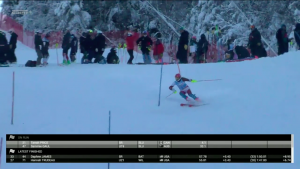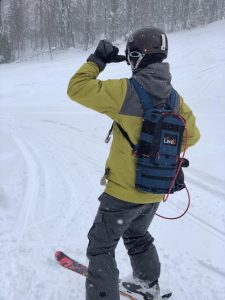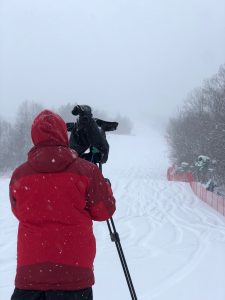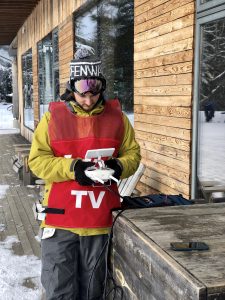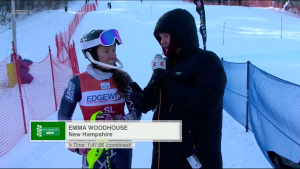Crimson Production Team Braves the Elements During First Harvard Carnival
Unpredictable weather played a factor in venue selection, tech execution
Story Highlights
Skiing down a hill at breakneck speeds is not for the faint of heart. Nor is producing a two-day, outdoor bonanza for Harvard University’s alpine and Nordic teams in sub-zero temperatures. On Jan. 17-18, the production crew dodged both natural and logistical obstacles to showcase the talents of the 15 participating institutions at the inaugural Harvard Carnival in Craftsbury, VT, and Waterville Valley, NH, on ESPN+.
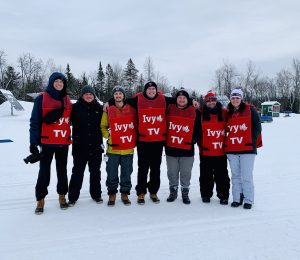
Videographer Andy Turne, Connor Clement, Charlie Bramhall, Austin Yayer, Zach Ostendorf, Ryan Saber, and SID Katie Habryle weather the storm for Harvard.
“We were hoping for 28 degrees and sunny, but it was not like that at all,” says Imry Halevi, assistant director of athletics, multimedia and production, Harvard University. “Waterville Valley was in the double-digit negative, with negative-40-degree wind chill in the morning, so it was really rough. I felt so bad for my team, but they were troopers with the weather and came dressed accordingly.”
Click HERE to register for SVG Webinar: Technology in Action on March 18, which will dive deeper into the production.
After 85 Years: The Genesis of Harvard’s Winter Wonderland
Harvard is known for giving equal airtime to all sports, including Olympics sports like water polo, fencing, and rowing. Despite this effort, skiing is one of the school’s 42 Division I programs that haven’t received much televised attention. While many colleges in the Northeast struggle to produce large-scale events like skiing carnivals, Halevi has aspired to host such an event for a long time.
“It has been a nugget in my head for quite a while, because Harvard has a very large athletic department,” he says. “Around October or November of 2019, I got wind that Harvard would be hosting its first-ever Harvard Carnival. We’ve had a ski program for 85 years and have never hosted a carnival. Our coaches were working very hard to make it happen. That’s when we first started thinking about it.
With a blue-sky idea, the production team linked up with the necessary individuals, Nordic skiing head coach Chris City and Alpine skiing head coach Scott MacPherson, from the athletic side to discuss how both sides could get on the same page.
“By mid November, they came to my office to sit down and talk, and that’s when [a plan] really started forming,” says Halevi. “They laid out what would be entailed, and their question was [whether] we could provide any kind of broadcast-video support.”
As the skiing teams were at work sharpening their physical skills for the event, Harvard’s technical team was putting in the mental reps to figure out the intricacies of the complicated production. The staff went to work inside their war room.
“Based on what the coaches told us, we had to figure out how we would provide coverage for something like this,” Halevi continues. “How many cameras would we need? Where would we put them? Would we do a local production or an [at-home] production? Would we have talent onsite or [at home]? In our heads, we realized that we’re not experts at this and it could all change, so we tried to figure out our plan with equipment vendors and equipment that we already have.”
In determining the site, the university scouted out multiple courses and locations to decide the best fit. When Waterville Valley and Dublin were selected as the sites of the alpine and Nordic races, respectively, testing was done to guarantee streaming reliability and inefficiency.
“We set up dates to go and visit Waterville and Dublin,” he says. “We stopped at several locations and talked about potential camera locations and sightlines. We brought a LiveU pack with us and did some transmission testing and communications back and forth with our controller to see if it was feasible that way, and it was great.”
A Last-Second Switch: Warm Weather Drives Competition 168 Miles North
Anyone covering live sports events needs to be nimble enough to sidestep any mishaps. On most occasions, though, the event’s environment isn’t changed to another location, let alone a different state. For the Harvard Carnival, one of the two sites was affected by an odd day of warm weather in the Northeast during the dead of winter.
“We had 67-degree weather in Boston and in New Hampshire, so some of the snow just melted, and there was not enough snow to complete an entire course,” says Halevi. “The people at Waterville were extraordinary because they were committed to making snow for 48 hours straight in order for the course to be ready. The Dublin School did not have the capacity or the time to make enough snow for the races, and we had to move the [Nordic] races to Craftsbury. but we found that out four to five days before the carnival.”
In a short window, Halevi and company had to reevaluate crew schedules, camera placement, and the event’s cellular foundation. On the personnel side, the university adapted its plan of having two teams handle the two events. Given the lack of time and the counterproductivity of turning over an entire crew, the same team saw both events through to the finish.
When discussions with officials in Craftsbury began, the task of constructing connectivity turned into much more of an issue.
“They said, ‘We have Wi-Fi and wired internet, but the course is 5 km long, and they don’t have cell reception,’” Halevi says. “I said, ‘Well, we have four LiveU HEVC LU600 packs, they each have six or seven antennas inside, and they’re really good. We can get a LiveU Xtender [for Nordic], so we know what we’re doing.’ But they said, ‘No, you misunderstood. It’s not quirky or consistent, there is no cell reception at all.’”
An All-Encompassing Effort: At-Home Production, Free-Range Drone Top the Tech
The external factors of an odd weather pattern, unforeseen venue swaps, and spotty cell reception weren’t enough to hamper Halevi and his crew in New Hampshire and the far reaches of Vermont, near the Canadian border.
In terms of the live stream’s connectivity, Harvard paired the LiveU equipment with traditional fiber laid at the facility in Craftsbury. The crew had enough confidence in the infrastructure that they decided to gamble with a workflow that meshed both an onsite team — comprising three full-time interns and two permanent members of the staff — and an offsite team, led by Halevi on campus in Cambridge, MA.
“We did an [at-home] production where I was back in the control room with a couple of people doing replay [Liam Donovan and Conor Alden] and one doing graphics [Conor McLaughlin],” he says. “We split our commentary crew, so we had one offsite [Kevin Gehl for alpine, Craig White for Nordic] providing results and overview and bio information and one onsite [Connor Clement], who provided context and weather updates but also did lots of interviews.
The production hub in Cambridge grabbed footage from both locations via a LiveU four-channel receiver and communicated with the onsite staff via a LiveU talkback incorporated into the university’s ClearCom system in the control room.
For both events, a mix of JVC GY-HC500U and GY-HM600U cameras controlled by Charlie Bramhall, Austin Yayer, Zach Ostendor, and Ryan Saber anchored the live stream, but, for the Nordic race, a drone (which the school deploys during the Ivy League Rowing Championships) took flight for aerial views above the action.
“We connected a drone to our LiveU pack and the LiveU pack to Wi-Fi,” says Halevi. “The drone was able to fly over most of the course and provide coverage of what people should be seeing.
Carnival in the Cold: Onsite Crew Battles Frigid Temps, Snowy Terrain
In an event that merges a mountain and frigid conditions, two profound hurdles were evident: putting on a multi-hour show in the outdoors and navigating a downhill course.
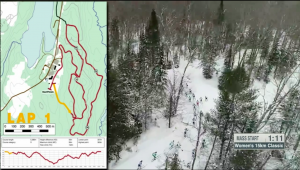
Halevi’s team used a drone and a map graphic with the course’s length and elevation to tell the story of the Nordic race on Day 2.
In the abysmal cold, keeping the equipment functional was a high priority. Even in an innovative production like this one, the crew went back to the basics for warmth.
“We got Portabrace cases and constantly put 80 hand warmers on all of our batteries, cameras, and gear because the cameras are rated to work at 32 degrees or warmer and definitely not anything negative,” says Halevi. “They also kept everything zipped up in bags as much as they could. The batteries lasted not as much time as they could have, but [the team] brought enough backup.”
A failed camera on the ground is one thing, but one failing from above was an accident waiting to happen.
“I was really worried about the drone because the drone isn’t really supposed to fly when it’s so cold out. But we got some advice to hover in place a little bit and let the drone warm up before you start flying it farther away. Ultimately, it never fell out of the sky dramatically, and none of the [other] cameras failed.”
Even though a good number of production students didn’t know how to ski, the unpredictable weather that caused the venue change turned out to be a blessing in disguise.
“The course was planned to be a Giant Slalom, which is a longer course, but they shortened it to a Slalom,” Halevi explains. “One student had his own skis. [Others were] provided lifts using a snowmobile or just walked with crampons that we provided. At Nordic, it wasn’t a problem at all because you just walk on that course.”
The Production Puzzle: How the University Evoked Creative Storytelling
Unlike with most other collegiate sports — particularly, football and basketball — producing a skiing event is a beast of its own. For example, instead of one individual going down the hill alone during a show like the Winter Olympics on NBC, the Harvard Carnival upped the complexity with two simultaneous runs. Halevi took that into account and devised a plan that would showcase the most pertinent skier during any specific run,
“There were times when we had three skiers at one time: one who was trying to make up the gate they lost, one who was already skiing, and one who just started,” he says. “We realized very early on that we couldn’t possibly show everyone. We were planning a picture-in-picture or split-split screen, but it was just too quick. We knew who was important and who was likely to win, so we made sure to focus on the people who could have some kind of significant time accomplishments.”
Since alpine skiing causes a constant cycle of bodies going downhill, capturing the stats and data for each person became a bit difficult. Luckily, Harvard relied heavily on the timing company that the team worked with to display the names, schools, and live clocks of skiers currently on the hill.
Static camera positions were filtered in and out of the live stream when applicable, but, on a massive course, the free-range device came in handy when telling the entire story of the second day of the carnival.
“For the men, it’s four times around a 5-km track; for the women, it’s three times around,” Halevi notes. “So, for 50 minutes, we were just sitting there. We tried to provide some live coverage with the drone and the cameras, but there were many, many times when we just could not see anyone.”
To establish a sense of place, the team developed a map of the entire Nordic course and inserted it into the live stream in a two-box format next to the live drone footage. The graphic not only outlined the competitors’ position and progress in the race but also indicated land elevation and course terrain.
“Ideally, we would have had a hundred cameras all the way around the course to show people skiing at all times,” he adds. “That would be amazing, but we couldn’t do that, so we were trying to make up for that deficiency with graphics, and our viewers had something to watch.”
All of these decisions played into Halevi’s goal of a balanced production. This entailed the presentation of the sport in its simplest form for first-time viewers while also giving diehard skiing fans something to chew on.
“You need to explain what course they’re running, how long it should take, what they’re supposed to do, what the expectations are, what it means when someone does well and when they don’t do well. But you also can’t be condescending, because you’re going to have a lot of ski alumni and ski fans.”
Postproduction Recap: Halevi Embraces the Challenge To Improve in the Future
The broadcast could have gone wrong at any moment, but Halevi and the Harvard Crimson production team pulled off a successful show. Even so, there were a few things the architect behind the project would do again if he had a do-over.
“It wasn’t perfect, and I will be the first one to admit it,” he says. “If we got to do this again in a couple of months, there are many things I would change to make this a better experience for my team and a better experience for the viewers. [For example], if I was to do Nordic again, I would use a lot more fiber.”
Despite the critiques, there is always room for self-praise after executing an epic production of this magnitude.
“We’ve heard nothing but positive feedback from our coaches, alumni, fans, and viewers,” Halevi says. “It’s great that we were able to pull something off without breaking the bank, because we didn’t have a million dollars at our disposal. We rented or leased some of the LiveU packs; we’re going to use those throughout the year for rowing, outdoor track, and other things that we’re doing. It was a good way to test them out and make sure we’re ready to go.”
The skiing spectacle captured the essence of live television production and how effective communication and a strong team bond can overcome the most unlikely of scenarios.
“It’s an outdoor sport, so you have to expect the unexpected,” Halevi points out. “It all came down to staffing and people: you need people you can trust to make it work. They made the whole thing possible because they were able to think on their feet and adjust as needed based on the conditions around them.”
Harvard’s technical achievement can be seen in a replay of Day 1 and Day 2 on ESPN+ or in a video recap of the event.
